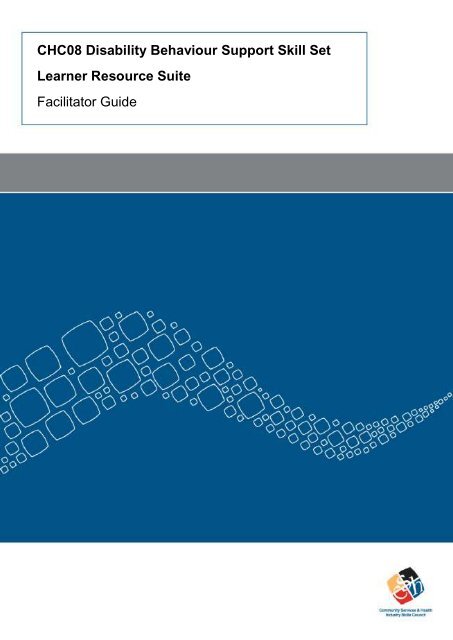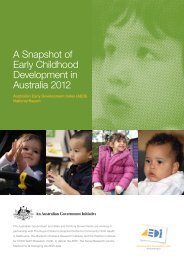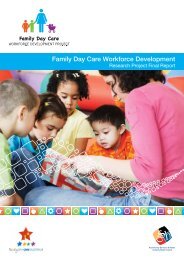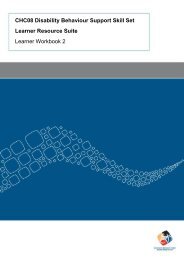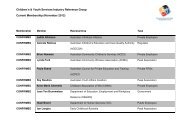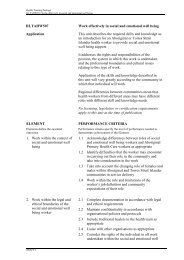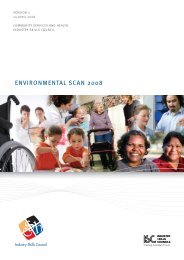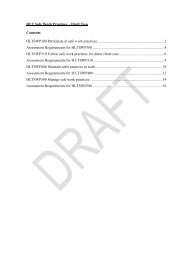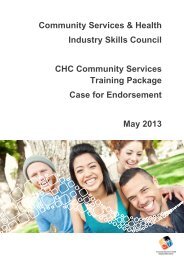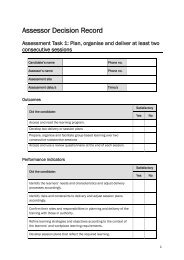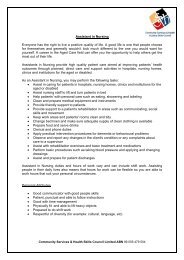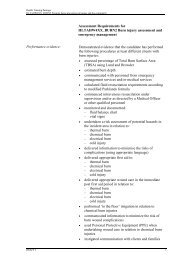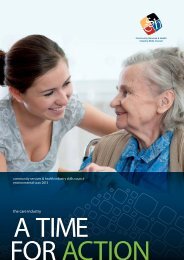Facilitator Guide - Community Services & Health Industry Skills ...
Facilitator Guide - Community Services & Health Industry Skills ...
Facilitator Guide - Community Services & Health Industry Skills ...
You also want an ePaper? Increase the reach of your titles
YUMPU automatically turns print PDFs into web optimized ePapers that Google loves.
CHC08 Disability Behaviour Support Skill Set<br />
Learner Resource Suite<br />
<strong>Facilitator</strong> <strong>Guide</strong>
CHC08 Disability Behaviour Support Skill Set<br />
<strong>Facilitator</strong> <strong>Guide</strong><br />
Introduction<br />
The <strong>Community</strong> <strong>Services</strong> and <strong>Health</strong> <strong>Industry</strong> <strong>Skills</strong> Council (CS&HISC) is the recognised<br />
advisory body on skills and workforce development across Australia for the two important<br />
industries of community services and health. Through ongoing research, consultation and<br />
industry engagement CS&HISC is able to identify the changes required within vocational and<br />
work-based training, and develop the national qualifications to support ongoing skill<br />
development.<br />
This suite of resources has been developed to support the Disability Work: Behaviour<br />
Support Skill Set from the <strong>Community</strong> <strong>Services</strong> (CHC08) Training Package.<br />
© <strong>Community</strong> <strong>Services</strong> and <strong>Health</strong> Industries <strong>Skills</strong> Council Ltd www.cshisc.com.au Page 1 of 42
Disability work skill set – behaviour support<br />
CHC08 Disability Behaviour Support Skill Set<br />
<strong>Facilitator</strong> <strong>Guide</strong><br />
Target group<br />
This skill set has been endorsed by industry as appropriate<br />
for people who hold a community services qualification at<br />
Certificate III level or higher or commensurate industry skills<br />
as evaluated through recognition of prior learning processes.<br />
It provides a set of skills required for programs to support<br />
people with a disability who have behaviours of concern.<br />
Units<br />
CHCCS400C Work within a relevant legal and ethical<br />
framework<br />
CHCDIS409B Provide services to people with disabilities with<br />
complex needs<br />
CHCDIS411A Communicate using augmentative and<br />
alternative communication strategies<br />
CHCICS404B Plan and provide advanced behaviour support<br />
Pathway<br />
These units may provide credit towards a range of<br />
community sector qualifications at Certificate IV or Diploma<br />
level.<br />
Required form of<br />
words for<br />
Statement of<br />
Attainment<br />
This skill set meets industry requirements as specified in the<br />
CHC08 <strong>Community</strong> <strong>Services</strong> Training Package to manage a<br />
service delivery program which supports people with a<br />
disability who have behaviours of concern.<br />
Please be aware that although these learner guides may sometimes refer to clients who<br />
have a disability and are aging or living in an aged care facility, they have been written within<br />
the context of disability services, not within the context of aged care. Similarly these guides<br />
© <strong>Community</strong> <strong>Services</strong> and <strong>Health</strong> Industries <strong>Skills</strong> Council Ltd www.cshisc.com.au Page 2 of 42
CHC08 Disability Behaviour Support Skill Set<br />
<strong>Facilitator</strong> <strong>Guide</strong><br />
are not written within the content of children’s services, as they refer to adolescents over 14<br />
years of age, and to adults. The focus in the disability sector is to enhance and develop<br />
clients’ skills, whereas in aged care the focus is on helping clients maintain independence<br />
with diminishing skills.<br />
Trainers who utilise this learner guide must be aware of the current restrictions and<br />
jurisdictional limitations which apply to the scope of practice of disability services workers.<br />
Organisational policies and procedures must also be taken into consideration by both<br />
trainers and workers when applying the work procedures outlined in this guide.<br />
© <strong>Community</strong> <strong>Services</strong> and <strong>Health</strong> Industries <strong>Skills</strong> Council Ltd www.cshisc.com.au Page 3 of 42
Using the Learner <strong>Guide</strong><br />
CHC08 Disability Behaviour Support Skill Set<br />
<strong>Facilitator</strong> <strong>Guide</strong><br />
Symbols used in the learner guide<br />
<br />
This symbol indicates that there are assessment activities or exercises<br />
to complete that will help in developing the required knowledge and<br />
skills to achieve the specific performance criteria<br />
Structure<br />
This suite of resources contains the following sections<br />
a) <strong>Facilitator</strong> <strong>Guide</strong> Introduction and mapping<br />
b) Learner <strong>Guide</strong> 1 Working within a legal and ethical framework<br />
c) Learner <strong>Guide</strong> 2 Communication<br />
d) Learner <strong>Guide</strong> 3 Plan and Provide Advanced Behaviour Support<br />
e) Learner <strong>Guide</strong> 4 Provide <strong>Services</strong> to Support Complex Needs<br />
Method of assessment<br />
Assessment must include questioning (verbal and written) to address essential knowledge<br />
as outlined on page 24.<br />
Assessment will also include:<br />
<br />
<br />
<br />
<br />
<br />
observation of work performance<br />
supporting statement of supervisor or health professional<br />
authenticated evidence of relevant work experience and/or formal/informal learning<br />
case studies and scenarios as a basis for discussion of issues and strategies to achieve<br />
required infection control outcomes in specific work environments and communities<br />
written assessment of functional English language, literacy and numeracy skills<br />
appropriate to the level of responsibility of the care worker<br />
© <strong>Community</strong> <strong>Services</strong> and <strong>Health</strong> Industries <strong>Skills</strong> Council Ltd www.cshisc.com.au Page 4 of 42
Glossary<br />
CHC08 Disability Behaviour Support Skill Set<br />
<strong>Facilitator</strong> <strong>Guide</strong><br />
Terms which you will see used in this resource include:<br />
AAC<br />
AAC strategies<br />
AAC systems<br />
ABC chart<br />
Acquired brain injury<br />
(ABI)<br />
Acquired disability<br />
Ageing<br />
Amyotrophic lateral<br />
sclerosis<br />
Anger management<br />
Anxiety disorders<br />
ASD – autism<br />
Augmentative and alternative communication that is not speech,<br />
and is used to enhance or replace speech.<br />
How AAC is used to be effective for the client.<br />
Range of AAC aids, symbols and strategies which supplement<br />
speech.<br />
A way to analyse behaviour. The A stands for Antecedent, which<br />
is what happened before, the B stands for the Behaviour, itself,<br />
and C stands for Consequence, meaning the result of the<br />
behaviour.<br />
Refers to any type of brain damage which occurs after birth. ABI<br />
can include damage sustained from an infection, disease, lack of<br />
oxygen or a blow to the head.<br />
A disability that has occurred after the time of birth.<br />
Conditions such as Alzheimer’s and dementia are included<br />
separately as they are ageing related health conditions which<br />
can impact on existing disabilities and lead to complex<br />
communication needs.<br />
A disease of the nerve cells in the brain and spinal cord that<br />
control voluntary muscle movement<br />
Addresses the source of a person’s anger to develop strategies<br />
for the person to better manage their anger.<br />
Constant and heightened state of fear, nervousness, worry or<br />
feeling tense.<br />
A term which encompasses a range of autism presentations<br />
© <strong>Community</strong> <strong>Services</strong> and <strong>Health</strong> Industries <strong>Skills</strong> Council Ltd www.cshisc.com.au Page 5 of 42
spectrum disorder<br />
CHC08 Disability Behaviour Support Skill Set<br />
<strong>Facilitator</strong> <strong>Guide</strong><br />
which include autism, Asperger’s syndrome and other closely<br />
related developmental disorders. ASD can impair social<br />
interactions and communication, and produce restricted,<br />
repetitive and stereotypical behaviours, interests and activities.<br />
Asperger’s syndrome<br />
A mental developmental disorder at the higher functioning end of<br />
the autism spectrum.<br />
Aversive strategies<br />
Strategies which include restraint, seclusion and/or punishment<br />
to manage behaviour, and are not a preferred strategy.<br />
Barrier behaviours<br />
Behaviours which create barriers to relationship building such as<br />
withdrawn behaviours, aggressive, annoying disruptive, socially<br />
inappropriate, non-compliant and self-stimulating behaviours.<br />
Behaviours of concern<br />
“Behaviour of such intensity, frequency and duration that the<br />
physical safety of the person or others is placed or is likely to be<br />
placed in serious jeopardy, or behaviour which is likely to<br />
seriously limit use of, or result in the person being denied access<br />
to ordinary community facilities, services and experiences.”<br />
Dentified by Eric Emerson, Professor of Disability and <strong>Health</strong><br />
Research UK, 1995<br />
Behaviour Support<br />
Practitioner<br />
Practitioners who have tertiary qualifications in Psychology,<br />
Special Education, Speech Pathology, Social Work or other<br />
relevant disciplines, and/or training and experience in the<br />
provision of behavioural support and intervention.<br />
Behaviour support<br />
worker<br />
A generic term which refers to a skilled or experienced<br />
professional who assesses, develops, implements, monitors and<br />
reviews Positive Behaviour Support Plans.<br />
Cardiac<br />
An umbrella term for a variety of diseases affecting the heart.<br />
Carer<br />
“Carers provide unpaid care and support to family members and<br />
friends who have a disability, mental illness, chronic condition,<br />
terminal illness or who are frail or aged.” Defined by Carers<br />
© <strong>Community</strong> <strong>Services</strong> and <strong>Health</strong> Industries <strong>Skills</strong> Council Ltd www.cshisc.com.au Page 6 of 42
Australia)<br />
CHC08 Disability Behaviour Support Skill Set<br />
<strong>Facilitator</strong> <strong>Guide</strong><br />
Cerebral palsy<br />
Chemical restraint<br />
Client<br />
A group of disabilities that affect movement, posture and<br />
balance. The condition occurs when areas of the brain that<br />
control movement and posture do not develop correctly or are<br />
damaged.<br />
The use of medication for the specific purpose of controlling or<br />
influencing behaviour, mood or level of arousal.<br />
Refers to the person with a disability and clearly defines their role<br />
in the relationship with a worker. Clients may include:<br />
<br />
<br />
<br />
<br />
<br />
<br />
<br />
<br />
Individuals living in a residential aged care environment.<br />
Individuals living in the community.<br />
Prospective individuals to the service or services.<br />
Individuals living in government funded services.<br />
Job seekers.<br />
Children and young people.<br />
People seeking advice and assistance.<br />
Children and families using children’s services.<br />
Complex needs<br />
People who have multiple health, functional or social conditions<br />
where one condition affects the other conditions.<br />
Consent<br />
Containment<br />
Crisis response<br />
Permission given by a client or someone who has capacity to do<br />
so on behalf of them. To be valid consent must be voluntary,<br />
informed, specific and current. A person must be free to exercise<br />
genuine choice about whether or not to give or withhold consent.<br />
A practice used to support a person to regain personal control,<br />
by preventing access to events, conditions or environments that<br />
stimulate behaviour of concern.<br />
A response in situations where the client is engaging in<br />
behaviour of concern and risk intervention is necessary.<br />
© <strong>Community</strong> <strong>Services</strong> and <strong>Health</strong> Industries <strong>Skills</strong> Council Ltd www.cshisc.com.au Page 7 of 42
CHC08 Disability Behaviour Support Skill Set<br />
<strong>Facilitator</strong> <strong>Guide</strong><br />
Critical incident<br />
Degenerative<br />
neurological disease<br />
Dementia<br />
Depression<br />
Disability<br />
Disability <strong>Services</strong><br />
Organisation<br />
Down syndrome (DS)<br />
Epilepsy<br />
An unexpected or unplanned action or event which results or has<br />
the potential to result in harm to the person, others or property.<br />
Conditions that affect the nervous system, which become more<br />
severe over time. Some examples of progressive neurological<br />
disorders are Motor Neurone Disease, Parkinson’s disease and<br />
Multiple Sclerosis.<br />
A progressive deterioration in a person’s functioning. The most<br />
common cause is Alzheimer’s disease but there are other causes<br />
including Parkinson’s disease and Huntington’s disease.<br />
Common early symptoms include memory loss, confusion,<br />
personality changes, apathy and withdrawal.<br />
Depression is more than just a low mood, it is a serious illness.<br />
While we all feel sad, moody or low from time to time, some<br />
people experience these feelings intensely, for long periods of<br />
time and often without reason. People with depression find it<br />
hard to function every day and may be reluctant to participate in<br />
activities they once enjoyed.<br />
“Long-term physical, mental, intellectual or sensory impairments<br />
which, in interaction with various attitudinal and environmental<br />
barriers, hinders their full and effective participation in society on<br />
an equal basis with others.” Defined by the United Nations<br />
Convention on the Rights of Persons with Disabilities<br />
A generic name for an organisation offering services to people<br />
with disabilities.<br />
Also called Trisomy 21, is a condition in which extra genetic<br />
material causes delays in the way a child develops, both mentally<br />
and physically.<br />
A common chronic neurological disorder characterised by<br />
seizures. These seizures are transient signs and/or symptoms of<br />
abnormal, excessive or hypersynchronous neuronal activity in<br />
© <strong>Community</strong> <strong>Services</strong> and <strong>Health</strong> Industries <strong>Skills</strong> Council Ltd www.cshisc.com.au Page 8 of 42
CHC08 Disability Behaviour Support Skill Set<br />
<strong>Facilitator</strong> <strong>Guide</strong><br />
the brain. Epilepsy in people with a learning disability is 20 times<br />
higher and 30 times higher in people with severe multiple<br />
disabilities.<br />
Exclusionary time-out<br />
An intervention which removes the person for a period of time<br />
from a situation which is promoting or reinforcing behaviour of<br />
concern.<br />
Global developmental<br />
delay<br />
A delay in two or more important areas of development. These<br />
areas include motor skills, speech and language skills, academic<br />
skills, learning ability, social and emotional skills and self-help<br />
skills.<br />
Guardian<br />
A person who is appointed to make decisions on behalf of a<br />
family member or friend.<br />
<strong>Health</strong> conditions<br />
Any physical condition which causes pain, anxiety or fatigue,<br />
often affecting a person’s ability to communicate.<br />
Immediate response<br />
strategies<br />
Strategies aimed at de-escalating or managing behaviour of<br />
concern such as redirection, talking about the issue, responding<br />
to early signs of the behaviour, anger management.<br />
Implementer<br />
A person who is identified as responsible for the implementation<br />
of documented behaviour support strategies. Implementers may<br />
include family members, carers, staff or other stakeholders.<br />
Incident Prevention<br />
and Response Plan<br />
A written plan containing one or a number of strategies that have<br />
been developed in order to:<br />
(IPRP)<br />
<br />
<br />
<br />
Prevent the behaviour of concern<br />
Intervene in the escalation cycle of the behaviour and<br />
Respond to such behaviour when it does occur so that it<br />
can be managed as quickly and safely as possible.<br />
Incidental or informal<br />
learning<br />
Education that happens outside of the learning sessions when<br />
instructions are given and often happens outside of the home.<br />
© <strong>Community</strong> <strong>Services</strong> and <strong>Health</strong> Industries <strong>Skills</strong> Council Ltd www.cshisc.com.au Page 9 of 42
CHC08 Disability Behaviour Support Skill Set<br />
<strong>Facilitator</strong> <strong>Guide</strong><br />
Individual Plans<br />
Intellectual disability<br />
(ID)<br />
An umbrella term used in this competency to describe the plans<br />
for clients, which include Service Delivery Plans, Individual<br />
Personal Plans, Personal Development Plans and Care Plans.<br />
These plans include a client’s long-term and short-term goals,<br />
augmentative and alternative communication strategies,<br />
behaviour support and responses which address their needs and<br />
aims to improve their quality of life.<br />
There are three core features that people must have in order to<br />
receive a diagnosis of intellectual disability:<br />
1. An IQ score of less than 70.<br />
2. Difficulties with adaptive skills such as following directions<br />
and understanding abstract concepts.<br />
3. The existence of the first two characteristics before the<br />
age of 18.<br />
Last resort<br />
Learning styles –<br />
auditory<br />
Learning styles –<br />
kinaesthetic<br />
Learning styles –<br />
visual<br />
Least restrictive<br />
alternative<br />
An emergency response which is used because the crisis<br />
response strategies are not working. These include selfprotection<br />
strategies. Last resort can also include restrictive<br />
practices, which cannot be implemented without informed<br />
consent as they are a restriction of a person’s freedom, or an<br />
intrusion on their dignity.<br />
Learn through listening and talking.<br />
Learn through touching and moving.<br />
Learn through seeing what they need to learn.<br />
A practice or intervention which creates the least restrictive<br />
option to prevent harm to the client and is applied no longer than<br />
is necessary to manage an identified risk.<br />
© <strong>Community</strong> <strong>Services</strong> and <strong>Health</strong> Industries <strong>Skills</strong> Council Ltd www.cshisc.com.au Page 10 of 42
CHC08 Disability Behaviour Support Skill Set<br />
<strong>Facilitator</strong> <strong>Guide</strong><br />
Literacy and numeracy<br />
skills<br />
Makaton<br />
Ability to read, write, use numbers and recognise colour.<br />
Makaton uses speech and gesture, facial expression, eye<br />
contact and body language. It is a language programme which is<br />
based on a selected list of everyday words<br />
http://www.makaton.org/about/how-makaton-works.htm<br />
Manager<br />
Mechanical restraint<br />
Motivation –<br />
demotivator<br />
Motivation – extrinsic<br />
Motivation – intrinsic<br />
Motor neurone disease<br />
(MND)<br />
Motor skills – fine<br />
Motor skills – gross<br />
Multiple sclerosis (MS)<br />
This is whoever you report to in your disability services<br />
organisation. Other titles which we include in this term may be<br />
supervisor, coordinator, CEO or director.<br />
The restraint of a person’s movement or behaviour by the use of<br />
a device that restricts, prevents or subdues a person’s<br />
movement.<br />
Obstacles which challenge motivation needed to learn a new skill<br />
or achieve a goal .<br />
Reflects the desire to do something because of external rewards<br />
such as money, and praise.<br />
Those activities which a person will engage in for no reward<br />
other than the interest, enjoyment and want to gain the benefits<br />
of learning a new skill.<br />
A group of neurological diseases, which involve deterioration of<br />
parts of the brain leading to muscle weakness and wasting.<br />
Require the use of smaller muscle groups to perform tasks that<br />
are precise in nature.<br />
This requires the use of large muscle groups to perform tasks<br />
like walking, lifting, pushing, bending or balancing.<br />
A chronic, often disabling disease that affects the central nervous<br />
system.<br />
© <strong>Community</strong> <strong>Services</strong> and <strong>Health</strong> Industries <strong>Skills</strong> Council Ltd www.cshisc.com.au Page 11 of 42
CHC08 Disability Behaviour Support Skill Set<br />
<strong>Facilitator</strong> <strong>Guide</strong><br />
Muscular dystrophy<br />
(MD)<br />
A group of inherited conditions, which means they are passed<br />
down through families. They may occur in childhood or<br />
adulthood. There are many different types of muscular dystrophy:<br />
<br />
<br />
<br />
<br />
<br />
<br />
<br />
Becker muscular dystrophy<br />
Duchenne muscular dystrophy<br />
Emery-Dreifuss muscular dystrophy<br />
Facioscapulohumeral muscular dystrophy<br />
Limb-girdle muscular dystrophy<br />
Myotonia congenita<br />
Myotonic dystrophy<br />
Negligence<br />
Over-correction<br />
Pain and discomfort<br />
Participation model<br />
Person centred<br />
approach<br />
Physical restraint<br />
Positive approaches<br />
A failure to exercise reasonable care and skill to avoid<br />
foreseeable harm by someone who owes a duty of care to<br />
another.<br />
A response which is disproportionate to an event and does more<br />
than is necessary to restore a disrupted situation to its original<br />
condition. For example, requiring a person to clean an entire<br />
dining room where they have deliberately tipped a meal on the<br />
floor<br />
General health conditions that cause physical irritation, such as<br />
infections, ear ache, toothache, PMT. This pain affects<br />
concentration.<br />
Provides an organised, consistent and systematic way to<br />
undertake assessments related to AAC strategies. This model is<br />
used throughout this competency.<br />
This approach focuses on the client, their needs, concerns and<br />
wants.<br />
The restriction of a person’s movement or behaviour by the use<br />
of a device or physical force.<br />
An approach to behaviour support that provides a respectful and<br />
© <strong>Community</strong> <strong>Services</strong> and <strong>Health</strong> Industries <strong>Skills</strong> Council Ltd www.cshisc.com.au Page 12 of 42
CHC08 Disability Behaviour Support Skill Set<br />
<strong>Facilitator</strong> <strong>Guide</strong><br />
sensitive environment so the client is empowered to achieve and<br />
maintain their individual lifestyle goals. These include nonaversive,<br />
person-centred, solution-focussed, holistic and skillbased.<br />
Positive Behaviour<br />
Support Plan<br />
(Behaviour Management<br />
Plan or Behaviour<br />
A document or a series of linked documents that outline<br />
strategies designed to deliver a level of behaviour support<br />
appropriate to the needs of a client. This has a preventative and<br />
a responsive focus.<br />
Intervention Plan)<br />
Positive behaviour<br />
support strategies<br />
Development of strategies which use inclusion, applied<br />
behaviour analysis and person centred practices to manage<br />
behaviour and support an adult client to reduce the occurrence of<br />
behaviours of concern. It includes an assessment of their current<br />
behaviours, planning, implementation and monitoring of<br />
strategies to meet the client’s needs, improve their capabilities<br />
and quality of life and reduce the occurrence of the behaviour<br />
that causes harm. Positive behaviour support is included in their<br />
individual plan.<br />
Positive practices<br />
Practices which are consistent with the principles of the positive<br />
approach.<br />
Proactive strategies<br />
Strategies which support behaviour changes and include<br />
changes in the environment, positive intervention and<br />
reinforcement strategies.<br />
Prohibited practice<br />
Practices which interfere with basic human rights, are unlawful<br />
and unethical such as physical, verbal emotional abuse or<br />
deprivation.<br />
Prompts<br />
Assist learners to communicate.<br />
Psychiatric disability<br />
Affects the ability of the person to perform everyday living tasks<br />
and to develop and maintain effective personal and social<br />
© <strong>Community</strong> <strong>Services</strong> and <strong>Health</strong> Industries <strong>Skills</strong> Council Ltd www.cshisc.com.au Page 13 of 42
elationships<br />
CHC08 Disability Behaviour Support Skill Set<br />
<strong>Facilitator</strong> <strong>Guide</strong><br />
Psychoactive or<br />
psychotropic<br />
medication<br />
Psychosis<br />
Psychosocial restraint<br />
Reactive strategies<br />
Restricted access<br />
Restricted practice<br />
Restricted Practice<br />
Authorisation (RPA)<br />
Seclusion<br />
Sensory disability<br />
Service Delivery Plan<br />
Influence cognitive ability i.e. affects thought processes and<br />
behaviour.<br />
A group of illnesses which disrupt the functioning of the brain so<br />
much so that a person is unable to distinguish what is real.<br />
Verbal interactions which use fear to change a person’s<br />
behaviour such as intimidating language, yelling, or abusive<br />
language.<br />
Strategies which need to be actioned quickly and can include<br />
immediate responses, anger management or crisis response.<br />
The use of physical barriers such as locks or padlocks, increased<br />
supervision, or boundaries in an environment in order to restrict a<br />
person’s access.<br />
Practices that use seclusion, procedures, restraints and<br />
programs that prevent a person exercising choice and selfdetermination.<br />
A formal authorisation to ensure that the use of any restricted<br />
practice is clinically justifiable and can be safely implemented<br />
within policy and practice requirements. This authorisation is<br />
formal, conditional and time-limited.<br />
The placement of a person in isolation for a specified time in an<br />
environment from which they cannot leave, usually as a crisis<br />
response.<br />
Hearing impairment, visual impairment or both.<br />
A type of Individual Plan which must be developed in conjunction<br />
with the client so the plan remains client-focused, as well as<br />
involving the client’s family, primary carers and other significant<br />
© <strong>Community</strong> <strong>Services</strong> and <strong>Health</strong> Industries <strong>Skills</strong> Council Ltd www.cshisc.com.au Page 14 of 42
CHC08 Disability Behaviour Support Skill Set<br />
people to ensure the plan is realistic.<br />
<strong>Facilitator</strong> <strong>Guide</strong><br />
Socially inappropriate<br />
or unacceptable<br />
behaviour<br />
Spina bifida<br />
Any behaviour which is socially unacceptable or inappropriate in<br />
a given situation making others feel uncomfortable or annoyed.<br />
For example fondling private parts is acceptable in privacy, and<br />
not in public.<br />
In spina bifida some of the spinal vertebrae are not completely<br />
formed but are split or divided and the defective spinal cord and<br />
its coverings usually protrude through the opening.<br />
STAR chart Away to analyse behaviour. The S - Setting, T - Trigger, A -<br />
Action and R - Response.<br />
Stroke<br />
Traumatic brain injury<br />
(TBI)<br />
Worker/disability<br />
services worker<br />
Failure of blood supply to the brain that results in injury to part of<br />
the brain.<br />
Permanent or temporary brain damage caused by trauma to the<br />
head.<br />
This term refers to a person providing a service or support to a<br />
person or people with a disability. Occupational titles may<br />
include:<br />
<br />
<br />
<br />
<br />
<br />
<br />
<br />
<br />
<br />
<br />
<br />
<br />
<br />
Behavioural support officer<br />
Development officer<br />
Disability officer – day support<br />
Disability support officer/worker<br />
Employment coordinator (disability)<br />
Job coordinator<br />
Lifestyle support officer<br />
Local area coordinator<br />
Marketing coordinator<br />
Project officer (life enhancement team)<br />
Residential care officer<br />
Senior project care assistant<br />
Social educator<br />
© <strong>Community</strong> <strong>Services</strong> and <strong>Health</strong> Industries <strong>Skills</strong> Council Ltd www.cshisc.com.au Page 15 of 42
CHC08 Disability Behaviour Support Skill Set<br />
<strong>Facilitator</strong> <strong>Guide</strong><br />
Social trainer<br />
Supervisor<br />
© <strong>Community</strong> <strong>Services</strong> and <strong>Health</strong> Industries <strong>Skills</strong> Council Ltd www.cshisc.com.au Page 16 of 42
<strong>Facilitator</strong> Resources<br />
CHC08 Disability Behaviour Support Skill Set<br />
<strong>Facilitator</strong> <strong>Guide</strong><br />
Following are a number of online resources which feature people with a range of disabilities.<br />
Choose the resources you want to use from these lists to increase a student’s understanding<br />
of the topic or a specific disability in relation to modern cultural elements.<br />
Disability Awareness DVD Intro<br />
http://www.youtube.com/watch?v=t_kInBFPBG8<br />
Dale Elliott introduces the soon to be released Disability Awareness DVD, which provides an<br />
insight into the social and working lives of people with a disability living in South Australia.<br />
Welcome to the ‘Disability: Our Stories’ Disability Awareness Program<br />
http://www.youtube.com/watch?v=OKSyVngD8kQ<br />
Jenny Fereday, nurse and midwife in the area of research and practice development at<br />
South Australia's Children, Youth and Women's <strong>Health</strong> Service, introduces the 'Disability:<br />
Our Stories' disability awareness program. You can use the ‘Disability: Our Stories’ resource<br />
in full at http://www.disabilitystories.org.au.<br />
Schools Program West Coast TAFE, Perth Western Australia<br />
http://www.youtube.com/watch?v=2ohEHZMFNr4<br />
West Coast TAFE enjoying our Wheelchair Basketball and Disability Awareness Program.<br />
Available for all age groups! For more information and bookings please visit<br />
www.wheelchairsportswa.org.au/schov.htm.<br />
© <strong>Community</strong> <strong>Services</strong> and <strong>Health</strong> Industries <strong>Skills</strong> Council Ltd www.cshisc.com.au Page 17 of 42
CHC08 Disability Behaviour Support Skill Set<br />
<strong>Facilitator</strong> <strong>Guide</strong><br />
Deaf-blind awareness... ‘a message to the world’<br />
http://www.youtube.com/watch?v=SJOnCBOY5SA<br />
Tony is deaf-blind and speech impaired. In these 15 minutes you will experience the world<br />
we deaf-blind people will experience for the rest of our lives. Deaf-blindness is a hidden<br />
disability that is growing in Australia and effects children, the elderly and adults like me.<br />
Given that 90% of the information we receive is through the eyes and ears, the deaf-blind<br />
only receive 10% of what is happening around them.<br />
Disability <strong>Services</strong> - University of South Australia<br />
http://www.youtube.com/watch?v=JTg-4Hgcxvk<br />
The University of South Australia is proud of the fact that it is a leader in Australia providing<br />
quality higher education for people with disabilities. .<br />
Don't DIS my ABILITY 2010 Ambassador Interviews.mov<br />
http://www.youtube.com/watch?v=va4hs55YdFo<br />
Deaf-blind Awareness Week 2010 - Vision Australia Radio - Part 1/4<br />
© <strong>Community</strong> <strong>Services</strong> and <strong>Health</strong> Industries <strong>Skills</strong> Council Ltd www.cshisc.com.au Page 18 of 42
http://www.youtube.com/watch?v=iVzvBxn_FQs<br />
CHC08 Disability Behaviour Support Skill Set<br />
<strong>Facilitator</strong> <strong>Guide</strong><br />
Able Australia on Vision Australia Radio discussing the disability of deaf-blindness and Deafblind<br />
Awareness Week 2010.<br />
Special Olympics Australia News - 2010 IX National Opening Ceremony<br />
and The Hon. Bill Shorten<br />
http://www.youtube.com/watch?v=rl-TBBXiRNY<br />
Special Olympics News with The Hon. Bill Shorten, Minister for Disabilities who addressed<br />
the stadium at the opening ceremony on 19 April 2010<br />
PART 2: Autism Awareness Video on Disabled Parking Permit Criteria<br />
http://www.youtube.com/watch?v=3A_D3IrLK9Q<br />
On 9 June 2009, Helen Howson and Allison Dix presented to the City of Tea Tree Gully<br />
(Adelaide, South Australia) in relation to Disability Parking Permits.<br />
Deaf-blind Awareness Week 2010 - Vision Australia Radio - Part 3/4<br />
http://www.youtube.com/watch?v=6JK716qQp5Q<br />
Able Australia on Vision Australia Radio discussing the disability of deaf-blindness and Deafblind<br />
Awareness Week 2010.<br />
© <strong>Community</strong> <strong>Services</strong> and <strong>Health</strong> Industries <strong>Skills</strong> Council Ltd www.cshisc.com.au Page 19 of 42
Disability awareness-not serious one as much<br />
CHC08 Disability Behaviour Support Skill Set<br />
<strong>Facilitator</strong> <strong>Guide</strong><br />
http://www.youtube.com/watch?v=9ppgubJ-R5E<br />
2009 Arthritis Australia Awareness TVC<br />
http://www.youtube.com/watch?v=gOCln2QKy34<br />
Arthritis is Australia’s major cause of disability and pain. Nearly one in five Australians, that's<br />
almost four million people, has arthritis and of these, 62% are of working age.<br />
Disabled World<br />
http://videos.disabled-world.com<br />
Disabled World Disability Videos feature information for and about persons with disabilities.<br />
The free video clips include subjects such as demonstrations of assistive technology,<br />
disability sports, homemade videos, teaching disability topics in classrooms, and general<br />
health information. Videos for the hearing impaired include news and disability topics in<br />
British Sign Language (BSL), American Sign Language (ASL), and captioning.<br />
© <strong>Community</strong> <strong>Services</strong> and <strong>Health</strong> Industries <strong>Skills</strong> Council Ltd www.cshisc.com.au Page 20 of 42
Reference Materials<br />
CHC08 Disability Behaviour Support Skill Set<br />
<strong>Facilitator</strong> <strong>Guide</strong><br />
Better Understand to Better Intervene<br />
Deafblindness and Mental <strong>Health</strong><br />
By Bolduc, Daniel (psychologist) dbolduc@raymond-dewar.gouv.qc.ca<br />
Brissette, Lyne (social worker) lbrissette@raymond-dewar.gouv.qc.ca<br />
Lefebvre, Gilles (deafblindness counsellor) glefebvre@raymond-dewar.gouv.qc.ca<br />
Institute Raymond-Dewar, Montreal<br />
Centre for <strong>Health</strong> Service Development<br />
http://ahsri.uow.edu.au/chsd/screening/index.html<br />
Challenging Behaviour Information Sheet<br />
http://www.cddh.monash.org/assets/chabev.pdf<br />
Department of Families, Housing, <strong>Community</strong> <strong>Services</strong> and Indigenous Affairs<br />
http://www.fahcsia.gov.au/sa/disability/pubs/documents/consumertrainingsupportproducts/e<br />
mployers/being_an_effective_manager/sec3.htm#t1<br />
Disability and ageing: Australian population patterns and implications<br />
www.aihw.gov.au<br />
Government of South Australia<br />
http://www.sa.gov.au/<br />
Principles of Delegation<br />
http://www.managementstudyguide.com/principles_of_delegation.htm<br />
© <strong>Community</strong> <strong>Services</strong> and <strong>Health</strong> Industries <strong>Skills</strong> Council Ltd www.cshisc.com.au Page 21 of 42
Queensland <strong>Community</strong> Care Conference<br />
CHC08 Disability Behaviour Support Skill Set<br />
<strong>Facilitator</strong> <strong>Guide</strong><br />
Quality Supports for People with Complex Needs and Challenging Behaviours or – ‘the<br />
pointy edge of compassion’<br />
Ian Boardman, Public Advocate – Queensland<br />
Delivered by Beverley Funnell, Senior Research Officer- Office of the Public Advocate<br />
7 October 2005<br />
Responding to People with Multiple and Complex Needs Project<br />
Client profile data and case studies report<br />
Department of Human <strong>Services</strong>, January 2003<br />
Responding to People with Multiple and Complex Needs Project<br />
Phase one and two report<br />
Department of Human <strong>Services</strong>, January 2003<br />
Websites for each state or territory:<br />
Positive Futures<br />
www.communities.qld.gov.au<br />
Behaviour support: Policy and Practice Manual<br />
www.adhc.nsw.gov.au/<br />
Positive behaviour support – getting it right from the start<br />
www.dhs.vic.gov.au<br />
Promoting Independence Promoting Independence: Disability Action Plans for SA<br />
www.familiesandcommunities.sa.gov.au<br />
Western Australia- Positive Behaviour Framework<br />
www.disability.wa.gov.au<br />
© <strong>Community</strong> <strong>Services</strong> and <strong>Health</strong> Industries <strong>Skills</strong> Council Ltd www.cshisc.com.au Page 22 of 42
CHC08 Disability Behaviour Support Skill Set<br />
<strong>Facilitator</strong> <strong>Guide</strong><br />
Disability Framework for Action 2005-2010: a whole-of government framework for<br />
Tasmanians with disabilities.<br />
www.dpac.tas.gov.au<br />
Future Directions: Towards Challenge 2014<br />
www.dhcs.act.gov.au<br />
The Northern Territory Disability Service Standards<br />
www.health.nt.gov.au<br />
© <strong>Community</strong> <strong>Services</strong> and <strong>Health</strong> Industries <strong>Skills</strong> Council Ltd www.cshisc.com.au Page 23 of 42
Assessment and Mapping<br />
CHC08 Disability Behaviour Support Skill Set<br />
<strong>Facilitator</strong> <strong>Guide</strong><br />
Best practice learning and assessment should be integrated (holistic), with assessment<br />
evidence being collected and feedback provided to the candidate at any time throughout the<br />
learning and assessment process.<br />
Structured learning and assessment programs may be:<br />
group-based<br />
work-based<br />
project-based<br />
self-paced<br />
action learning-based<br />
conducted by distance or e-learning and/or<br />
involving practice and experience in the workplace.<br />
Use of assessment tools<br />
Assessment tools provide a means of collecting the evidence that assessors use in making<br />
judgements about whether candidates have achieved competency.<br />
There is no set format or process for the design, production or development of assessment<br />
tools. Assessors may use prepared assessment tools, such as those specifically developed<br />
to support this Training Package, or they may develop their own.<br />
CS&HISC have developed an assessment tool to complement this suite of resources. The<br />
materials included in this assessment resource are:<br />
1. Pre-Assessment Interview Template<br />
The purpose of the pre-assessment interview tool is to provide an opportunity for the<br />
assessor and the candidate to work collaboratively and to plan and prepare for the<br />
assessment process. The template provides a guide to the assessor to facilitate<br />
discussions about the process of conducting the assessment.<br />
© <strong>Community</strong> <strong>Services</strong> and <strong>Health</strong> Industries <strong>Skills</strong> Council Ltd www.cshisc.com.au Page 24 of 42
CHC08 Disability Behaviour Support Skill Set<br />
<strong>Facilitator</strong> <strong>Guide</strong><br />
2. Assessors' <strong>Guide</strong> to Assessment<br />
The Assessor's <strong>Guide</strong> to Assessment supports the assessor in taking a strategic<br />
approach to best practice assessment. It provides the assessor with detailed information<br />
on planning and implementing the assessment process, customising and using and the<br />
assessment tools and providing feedback to candidates.<br />
3. Assessment Tools:<br />
• Workplace Observation & Documentation Checklist<br />
• Questions<br />
• Evidence Plan<br />
• Mapping <strong>Guide</strong> to Essential Knowledge & <strong>Skills</strong><br />
These tools assist the assessor in undertaking assessment against the essential skills. It<br />
incorporates all essential skills and related performance (tasks) that requires observationand<br />
includes the use of the range statement where applicable. Scenarios enable assessors<br />
and candidates to discuss how they would address particular issues and in so doing apply<br />
knowledge and skills relating to a number of units of competence in an integrated way to<br />
particular situations.<br />
The CHC08 Disability Work: Behaviour Support Assessment Resource can be downloaded<br />
from our resources library at www.cshisc.com.au<br />
Using prepared assessment tools<br />
If using prepared assessment tools, assessors should ensure these are benchmarked, or<br />
mapped, against the current version of the relevant unit of competency. This can be done by<br />
checking that the materials are listed on the www.training.gov.au register. Materials on the<br />
list have been noted by the National <strong>Skills</strong> Standards Council (NSSC) as meeting their<br />
quality criteria for Training Package support materials.<br />
Developing assessment tools<br />
When developing their own assessment tools, assessors must ensure that the tools:<br />
• are benchmarked against the relevant unit or units of competency;<br />
• are reviewed as part of the validation of assessment strategies required under the<br />
AQTF; and<br />
© <strong>Community</strong> <strong>Services</strong> and <strong>Health</strong> Industries <strong>Skills</strong> Council Ltd www.cshisc.com.au Page 25 of 42
CHC08 Disability Behaviour Support Skill Set<br />
<strong>Facilitator</strong> <strong>Guide</strong><br />
• meet the assessment requirements expressed in the AQTF Essential Standards for<br />
Registration.<br />
A key reference for assessors developing assessment tools is TAA04 Training and<br />
Assessment Training Package and the unit of competency TAAASS403A Develop<br />
assessment tools.<br />
Additional information may also be sourced at www.training.com.au<br />
© <strong>Community</strong> <strong>Services</strong> and <strong>Health</strong> Industries <strong>Skills</strong> Council Ltd www.cshisc.com.au Page 26 of 42
CHC08 Disability Behaviour Support Skill Set<br />
<strong>Facilitator</strong> <strong>Guide</strong><br />
CHCCS400B - Work within a relevant legal and ethical framework<br />
ELEMENT PERFORMANCE CRITERIA MAPPING<br />
1. Demonstrate an<br />
understanding of legislation and<br />
common law relevant to work role<br />
2. Follow identified policies<br />
and practices<br />
1.1 Demonstrate in all work, an understanding of the legal<br />
Part One: 1.1, 1.2<br />
responsibilities and obligations of the work role<br />
1.2 Demonstrate key statutory and regulatory requirements relevant Part One: 1.1, 1.2, 1.3, 1.4, 1.5<br />
to the work role<br />
1.3 Fulfil duty of care responsibilities in the course of practice Part One: 1.15, 1.16, 1.17, 1.18<br />
1.4 Accept responsibility for own actions Part One: 2.1, 2.2, 2.8, 2.9, 2.10<br />
1.5 Maintain confidentiality Part One: 1.30, 1.31, 2.6, 2.7<br />
1.6 Where possible, seek the agreement of the client prior to<br />
Part One: 2.7<br />
providing services<br />
2.1 Perform work within identified policies, protocols and procedures Part One: 2.1, 2.2<br />
2.2 Contribute to the review and development of policies and<br />
Part One: 2.10, 2.11<br />
protocols as appropriate<br />
2.3 Work within position specifications and role responsibilities Part One: 1.29, 1.23, 1.24, 2.2<br />
2.4 Seek clarification when unsure of scope of practice as defined by Part One: 1.24, 2.2, 2.8, 2.9, 2.10<br />
position description or specific work role requirements<br />
2.5 Seek clarification of unclear instructions Part One: 2.8, 2.9, 2.10<br />
3. Work ethically 3.1 Protect the rights of the client when delivering services Part One: 1.7, 1.8, 1.9, 3.2, 3.3<br />
3.2 Use effective problem solving techniques when exposed to Part One: 3.3, 3.6<br />
competing value systems<br />
3.3 Ensure services are available to all clients regardless of personal Part One: 3.4, 3.5,<br />
values, beliefs, attitudes and culture<br />
3.4 Recognise potential ethical issues and ethical dilemmas in the Part One: 3.7<br />
workplace and discuss with an appropriate person<br />
3.5 Recognise unethical conduct and report to an appropriate person Part One: 3.14<br />
3.6 Work within boundaries applicable to work role Part One: 1.29, 1.23, 1.24, 2.2, 3.3<br />
© <strong>Community</strong> <strong>Services</strong> and <strong>Health</strong> Industries <strong>Skills</strong> Council Ltd www.cshisc.com.au Page 27 of 42
4. Recognise and respond<br />
when client rights and interests<br />
are not being protected<br />
CHC08 Disability Behaviour Support Skill Set<br />
3.7 Demonstrate effective application of guidelines and legal<br />
Part One: 1.13<br />
requirements relating to disclosure and confidentiality<br />
3.8 Demonstrate awareness of own personal values and attitudes and Part One: 3.3<br />
take into account to ensure non-judgemental practice<br />
3.9 Recognise, avoid and/or address any conflict of interest Part One: 1.18<br />
4.1 Support the client and/or their advocate/s to identify and express Part One: 2.14<br />
their concerns<br />
4.2 Refer client and/or their advocate/s to advocacy services if Part One: 2.15, 2.18, 3.14<br />
appropriate<br />
4.3 Follow identified policy and protocols when managing a complaint Part One: 2.15, 2.16, 2.17<br />
4.4 Recognise witnessed signs consistent with financial, physical,<br />
emotional, sexual abuse and neglect of the client and report to an<br />
appropriate person as required<br />
4.5 Recognise and respond to cultural/linguistic religious diversity, for<br />
example providing interpreters where necessary<br />
Part One: 1.11, 1.12<br />
Part One: 3.8<br />
<strong>Facilitator</strong> <strong>Guide</strong><br />
Required <strong>Skills</strong> and Knowledge<br />
ESSENTIAL KNOWLEDGE<br />
MAPPING<br />
Distinction between ethical and legal problems Part One: 3.1<br />
Importance of ethics in practice Part One: 3.2<br />
Importance of principles and practices to enhance sustainability in the workplace, including environmental,<br />
economic, workforce and social sustainability<br />
Part One: 2.21<br />
Occupational health and safety (OHS) requirements Part One: 1.23 – 1.28<br />
Outline of common legal issues relevant to the workplace Part One: 1.3, 1.8, 1.10, 1.12, 1.23<br />
Overview of relevant legislation in the sector and jurisdictions Part One: 1.1, 1.2, 1.7, 1.10, 1.23<br />
Principles and practices for upholding the rights of the client Part One: 2.13, 2.14<br />
Principles and practices of confidentiality Part One: 1.30, 1.31<br />
Relevant standards and codes of practice in the sector Part One: 1.6, 1.7<br />
Rights and responsibilities of clients Part One: 1.3, 3.13<br />
© <strong>Community</strong> <strong>Services</strong> and <strong>Health</strong> Industries <strong>Skills</strong> Council Ltd www.cshisc.com.au Page 28 of 42
CHC08 Disability Behaviour Support Skill Set<br />
Rights and responsibilities of workers Part One: 1.3, 3.14<br />
Specific principles underpinning duty of care and associated legal requirements Part One: 1.15, 1.16, 1.17, 1.18<br />
Strategies for addressing common ethical issues Part One: 3.3, 3.7<br />
Strategies for contributing to the review and development of policies and protocols Part One: 2.20, 2.21<br />
Strategies for managing complaints Part One: 2.17<br />
Overview of the legal system Part One: 1.1, 1.2<br />
Principles and practices for upholding the rights of the children and young people Part One: 1.13, 1.18<br />
Principles of ethical decision-making Part One: 3.6<br />
Reporting mechanisms for suspected abuse of a client Part One: 1.1, 1.2, 1.3<br />
Strategies for managing abuse of a client Part One: 1.14<br />
Types of abuse experienced by client (including systems abuse) Part One: 1.11<br />
Types of law Part One: 1.1, 1.2<br />
<strong>Facilitator</strong> <strong>Guide</strong><br />
ESSENTIAL SKILLS<br />
MAPPING<br />
Demonstrate understanding of and adherence to own work role and responsibilities Part One: 2.1, 2.2<br />
Follow organisation policies, protocols and procedures Part One: 2.1<br />
Work within legal and ethical frameworks Part One: 1.1, 1.2<br />
Apply reading and writing skills required to fulfil work role in a safe manner and as specified by the<br />
Part One: 2.16, 2.19<br />
organisation<br />
Apply oral communication skills required to fulfil work role in a safe manner and as specified by the<br />
Part One: 1.28<br />
organisation<br />
Apply problem solving skills that require negotiation to resolve problems of a difficult nature within<br />
Part One: 2.14, 3.14<br />
organisation protocols<br />
Consult with a variety of stakeholders in order to achieve service objectives Part One: 2.8, 2.9, 2.20<br />
Part Two: 1.11, 2.8, 2.9, 2.10, 2.11<br />
© <strong>Community</strong> <strong>Services</strong> and <strong>Health</strong> Industries <strong>Skills</strong> Council Ltd www.cshisc.com.au Page 29 of 42
CHC08 Disability Behaviour Support Skill Set<br />
CHCDIS409A - Provide services to people with disabilities with complex needs<br />
ELEMENT PERFORMANCE CRITERIA MAPPING<br />
1. Evaluate and prioritise the<br />
needs of a person with complex<br />
care issues<br />
2. Liaise and negotiate with<br />
appropriate personnel in the<br />
development of a service delivery<br />
plan<br />
3. Coordinate the delivery of<br />
the service delivery plan<br />
4. Coordinate the monitoring,<br />
evaluation and review of the<br />
service delivery plan<br />
1.1 Demonstrate understanding of the impact dual/multiple diagnosis can have Part Four: 1.2, 1.3<br />
on identifying and prioritising needs<br />
1.2 Utilise purpose designed tools to assess specific problems of the older Part Four: 1.6, 1.7, 1.9<br />
person according to job role and responsibilities<br />
1.3 Seek advice from health professionals and other relevant personnel when Part Four: 1.8, 2.15, 2.16<br />
analysing and interpreting assessment data<br />
1.4 Recognise the impact of complex care issues on the carer/s Part Four: 1.10, 1.11, 1.14<br />
2.1 Utilise best practice guidelines when choosing strategies to address complex Part Four: 2.11, 2.12<br />
and/or special needs<br />
2.2 Liaise with relevant experts and health professional/s when developing Part Four: 2.15, 2.16<br />
service delivery plans<br />
2.3 Negotiate and establish goals with the person, their advocate/s and/or their Part Four: 1.4, 1.7, 2.1<br />
significant other/s, aiming to achieve maximum quality of life<br />
2.4 Access and/or negotiate resources in order to deliver identified services Part Four: 2.13, 2.14, 2.15, 2.16<br />
2.5 Access community support agencies to facilitate the achievement of<br />
Part Four: 2.16<br />
established goals<br />
3.1 Delegate services and care activities to appropriately skilled workers Part Four: 2.17, 2.18<br />
3.2 Recognise when a service and/or care worker is no longer able to provide Part Four: 2.19<br />
the level of service required<br />
3.3 Provide support and respite for the carer/s Part Four: 1.12, 1.13<br />
3.4 Determine all service providers’ understanding of the service delivery plan<br />
and their roles and responsibilities within that plan<br />
4.1 Determine all service providers’ understanding of the mechanism/s for<br />
providing feedback on the effectiveness of the service delivery plan<br />
4.2 Seek feedback from all service providers when evaluating effectiveness of<br />
the service delivery plan and re-prioritising care needs<br />
4.3 Seek feedback from the person and/or their advocate when evaluating<br />
effectiveness of the service delivery plan<br />
4.4 Seek advice and assistance from relevant health professionals when the<br />
person’s goals are not being reached<br />
Part Four: 2.7, 2.8, 2.10<br />
Part Four: 3.3, 3.4<br />
Part Four: 1.2, 3.3, 3.4, 3.5<br />
Part Four: 1.11, 2.1, 3.5<br />
Part Four: 2.18<br />
<strong>Facilitator</strong> <strong>Guide</strong><br />
© <strong>Community</strong> <strong>Services</strong> and <strong>Health</strong> Industries <strong>Skills</strong> Council Ltd www.cshisc.com.au Page 30 of 42
CHC08 Disability Behaviour Support Skill Set<br />
<strong>Facilitator</strong> <strong>Guide</strong><br />
Required <strong>Skills</strong> and Knowledge<br />
ESSENTIAL KNOWLEDGE<br />
MAPPING<br />
· Understanding of own work role and responsibilities Part Four: 1.8<br />
· Understanding of basic knowledge of physiology and psychology of a range of disability types and principles of Part Four: 1.1, 1.2<br />
assessment in determining, monitoring and evaluating the service needs of the person with complex or special needs<br />
as it relates to the work role<br />
· Relevant policies, protocols and practices of the organisation in relation to Unit Descriptor and work role Part One: 1.29, 1.23, 1.24, 2.2<br />
· Understanding of the manifestations and presentation of common health problems associated with different Part Four: 1.2<br />
disability types<br />
· Understanding of the manifestations and presentation of behavioural problems associated with different Part Four: 1.1<br />
disability types<br />
· Impact of cultural and individual differences of service plan development and delivery Part Four: 2.6<br />
· Role and function of various health professionals Part Two: 2.9<br />
· Types of community services and the services each provides Part Four: 2.16<br />
· Role of carers Part Four: 1.10<br />
· Principles and practices of assessment of individuals with complex and/or special needs Part Four: 1.4, 1.7, 1.8, 1.9<br />
· Strategies for conducting assessment of people with complex and/or special needs Part Four: 1.8, 1.9, 2.1, 2.2<br />
· Assessment tools used in the assessment of complex and/or special needs Part Four: 1.8, 1.9<br />
· Strategies for analysing and interpreting data Part Four: 2.3, 2.4<br />
· Processes and practices in developing and managing service delivery plans Part Four: 2.5, 2.6, 2.7, 2.8<br />
· Principles of delegation and supervision Part Four: 2.17<br />
· Strategies for conducting effective case conferences Part Four: 3.2<br />
· Principles and practices of case management Part Four: 2.2<br />
ESSENTIAL SKILLS<br />
MAPPING<br />
© <strong>Community</strong> <strong>Services</strong> and <strong>Health</strong> Industries <strong>Skills</strong> Council Ltd www.cshisc.com.au Page 31 of 42
CHC08 Disability Behaviour Support Skill Set<br />
· Prioritise and manage the changing service needs of clients with complex and special care needs Part Four: 1.5<br />
· Liaise and report to appropriately persons/agencies Part Four: 2.5, 2.8, 2.9<br />
· Adhere to own work role and responsibilities Part Four: 2.5, 2.8, 2.9<br />
· Recognise own limitations and the need for assistance Part Four: 2.18, 2.19<br />
· Work collaboratively with colleagues, health professionals and other services Part Four: 2.17, 2.18, 2.19<br />
· Apply problem solving skills that require negotiation and mediation skills to resolve problems of a difficult Part Four: 2.18, 2.19<br />
nature within organisation protocols<br />
· Collaborate and network with a variety of stakeholders in order to achieve service objectives Part Four: 2.15, 2.16<br />
· Safely use and coordinate the use of relevant technology effectively in line with occupational health and safety Part One: 1.23, 1.24, 1.25<br />
(OHS) guidelines<br />
· Follow organisation policies and protocols Part One: 2.1<br />
· Apply basic knowledge of physiology and psychology of different types of disability and principles of assessment<br />
in determining, monitoring and evaluating the service needs of the older person with complex or special needs as it<br />
relates to the work role<br />
· Apply reading and writing skills required to fulfil work role in a safe manner and as specified by the<br />
organisation/service:<br />
- this requires a level of skill that enables the worker to follow and give work-related instructions and directions and<br />
the ability to seek clarification and comments from clients, colleagues, health professionals and other service<br />
providers<br />
- industry work roles will require workers to possess a literacy level that will enable them to, read and write client’s<br />
service delivery plans, record in health records, complete assessment tools and write reports and submissions<br />
· Apply oral communication skills required to fulfil work role in a safe manner and as specified by the<br />
organisation:<br />
- this requires a level of skill that enables the worker to follow work-related instructions and directions and the<br />
ability to seek clarification and comments from supervisors, clients and colleagues<br />
- industry work roles will require workers to possess effective verbal and non-verbal communication skills that will<br />
enable them to ask questions, clarify understanding and meaning, recognise and interpret non-verbal cues, adapt<br />
communication styles to meet specific needs, provide information and express encouragement and support<br />
· Apply numeracy skills required to fulfil work role in a safe manner and as specified by the organisation:<br />
- industry work roles will require workers to be able to perform mathematical functions, such as addition and<br />
subtraction up to three digit numbers and multiplication and division of single and double-digit numbers<br />
Part Four: 1.1<br />
Part Four: 1.2, 1.6<br />
See also Part One: 2.8, 2.9, 2.10<br />
Part Four: 1.9, 2.4<br />
Part Four: 3.2, 3.5<br />
Part One: 2.8, 2.9, 2.10<br />
3.2, 3.5<br />
Part One: 2.8, 2.9, 2.10<br />
Part Four: 1.9<br />
See also Part Three: 2.2<br />
<strong>Facilitator</strong> <strong>Guide</strong><br />
© <strong>Community</strong> <strong>Services</strong> and <strong>Health</strong> Industries <strong>Skills</strong> Council Ltd www.cshisc.com.au Page 32 of 42
CHC08 Disability Behaviour Support Skill Set<br />
CHCDIS411A - Communicate using augmentative and alternative communication strategies<br />
ELEMENT PERFORMANCE CRITERIA ACTIVITY MAPPING<br />
1. Identify the current<br />
communication ability and<br />
needs of the person<br />
1.1 Work in collaboration with relevant others to identify the<br />
communication needs of person with a disability<br />
1.2 Use appropriate tools to identify the level of their current<br />
communication ability, in line with own work role and organisation<br />
requirements<br />
Part Two: 1.12, 1.13, 1.14, 2.6<br />
Part Two: 2.3, 2.4, 2.5, 2.6<br />
<strong>Facilitator</strong> <strong>Guide</strong><br />
2. Develop effective<br />
augmentative and<br />
alternative communication<br />
strategies<br />
1.3 Document the outcomes of this process in line with organisation<br />
procedures<br />
1.4 Identify the need to consult with additional people including family<br />
members<br />
1.5 Make appropriate referrals to professionals and other service<br />
providers as required<br />
2.1 Apply understanding of augmentative and alternative<br />
communication<br />
2.3 Develop communication strategies to meet individual needs and<br />
level of communication<br />
2.4 Take into account the person’s history and preferences when<br />
developing communication strategies<br />
2.5 Adjust available tools and programs to address individual needs and<br />
preferences<br />
Part Two: 1.15, 2.6<br />
See also Part One: 2.1, 2.2<br />
Part Two: 1.11, 2.8, 2.9, 2.10, 2.11<br />
Part Two: 2.9, 3.14, 3.22<br />
Part Two: 1.5, 1.6, 1.7<br />
Part Two: 1.7, 1.9, 1.13, 3.1<br />
Part Two: 2.1, 2.6, 2.7<br />
Part Two: 2.1, 2.6, 2.7, 3.19, 3.20<br />
3. Implement<br />
augmentative and<br />
2.6 Seek advice from other staff and relevant others Part Two: 1.10, 2.9, 3.14, 3.19, 3.20, 3.22<br />
3.1 Demonstrate the use of different strategies and devices in<br />
augmentative and alternative communication<br />
Part Two: 1.6, 1.7<br />
© <strong>Community</strong> <strong>Services</strong> and <strong>Health</strong> Industries <strong>Skills</strong> Council Ltd www.cshisc.com.au Page 33 of 42
alternative communication<br />
strategy<br />
CHC08 Disability Behaviour Support Skill Set<br />
3.2 Apply understanding of participation model as a communication<br />
strategy<br />
Part Two: 1.15<br />
<strong>Facilitator</strong> <strong>Guide</strong><br />
3.3 Document communication strategies in the person’s communication<br />
support plan or person-centred plan<br />
Part Two: 3.1<br />
3.4 Organise the environment to optimise communication opportunities Part Two: 3.6, 3.7<br />
3.5 Reinforce communication by timely and appropriate response Part Two: 3.3, 3.9<br />
3.6 Identify difficulties experienced by the person communicating and<br />
respond to difficulties within own work role and responsibilities<br />
Part Two: 3.15, 3.16, 3.22<br />
4. Monitor, report and<br />
review communication<br />
strategies<br />
3.7 Communicate difficulties outside own role and responsibilities to<br />
appropriate person<br />
3.8 Contribute to consistent use of the communication strategy by<br />
following established directions, by providing information and training<br />
and by maintaining contact with other users or support persons<br />
3.9 Set up and maintain recording system to assist with monitoring and<br />
review<br />
4.1 Review recordings to monitor success of communication strategies<br />
and make changes as required<br />
4.2 Identify barriers to the effective use of augmentative and alternative<br />
communication strategies and devices<br />
Part Two: 1.10, 2.9, 3.14, 3.20, 3.22<br />
See also Part One: 2.1, 2.2<br />
Part Two: 1.10, 2.10, 2.11, 3.12, 3.13, 3.14, 3.20<br />
Part Two: 3.13, 3.20<br />
Part Two: 3.15, 3.16, 3.17, 3.18, 3.20, 3.22<br />
Part Two: 2.7, 3.15, 3.16, 3.17, 3.18<br />
4.3 Work with other relevant people to overcome the barriers Part Two: 1.10, 1.13, 2.9, 3.22<br />
4.4 Implement any modifications to communication strategies and<br />
devices<br />
4.5 Identify opportunities to increase communication vocabulary Part Two: 3.18<br />
4.6 Maintain records according to established directions and within<br />
organisation protocols<br />
Part Two: 3.15, 3.16, 3.17, 3.18, 3.22<br />
Part Two: 2.6, 2.10, 3.13<br />
© <strong>Community</strong> <strong>Services</strong> and <strong>Health</strong> Industries <strong>Skills</strong> Council Ltd www.cshisc.com.au Page 34 of 42
CHC08 Disability Behaviour Support Skill Set<br />
<strong>Facilitator</strong> <strong>Guide</strong><br />
Required skills and knowledge<br />
ESSENTIAL KNOWLEDGE<br />
MAPPING<br />
· Principles and practices of augmentative and alternative communication Part Two: 1.5, 1.6, 1.8<br />
· The process for assessing for the use of augmentative and alternative communication Part Two: 1.13, 2.6, 1.12<br />
· Understanding of the different levels of communication Part Two: 1.2, 1.7<br />
· Recognition of communication styles of individuals Part Two: 2.1<br />
· Different communication skills relevant to client group e.g. signing Part Two: 1.6, 1.7<br />
· Basic knowledge of causes of communication impairment Part Two: 1.3, 2.3, 2.4<br />
· Cross cultural communication protocols Part Two: 2.6<br />
· Understanding of the influence of communication on behaviour Part Three: 2.1, 2.2<br />
· Understanding of the person’s communication level and its impact on skill development Part Two: 1.14<br />
· Understanding of the person’s communication level and its impact on their active community Part Two: 1.14<br />
participation<br />
· Roles and functions of different professionals in the development, implementation and<br />
Part Two: 2.8, 2.9<br />
maintenance of augmentative and alternative communication strategies and devices<br />
· Available range of communication aids and their correct use Part Two: 1.6, 1.7<br />
· Augmentative and alternative communication strategies and their correct use for the person’s Part Two: 1.7, 1.9<br />
level of communication<br />
· The total communication environment and the need for consistency Part Two: 3.6, 3.7<br />
· Role and responsibility as part of a team that supports augmentative and alternative<br />
Part Two: 1.1, 3.20<br />
communication<br />
· Task analysis Part Two: 3.2, 3.5, 3.7<br />
· Prompting, principles of prompting and fading prompting Part Two: 3.3, 3.5<br />
· Strategies to create independence Part Two: 3.4, 3.5<br />
· Reinforcers Part Two: 3.8. 3.9<br />
· Motivators to learn Part Two: 3.10, 3.11<br />
© <strong>Community</strong> <strong>Services</strong> and <strong>Health</strong> Industries <strong>Skills</strong> Council Ltd www.cshisc.com.au Page 35 of 42
CHC08 Disability Behaviour Support Skill Set<br />
· Common de-motivators and blocks Part Two: 2.7<br />
· Understanding of maintenance techniques and generalisation Part Two: 3.13, 3.23<br />
· Understanding of incidental learning Part Two: 3.11<br />
<strong>Facilitator</strong> <strong>Guide</strong><br />
ESSENTIAL SKILLS<br />
MAPPING<br />
It is critical that the candidate demonstrate the ability to:<br />
· Participate in a multi-disciplinary team Part Two: 1.10, 1.13, 2.9, 3.22<br />
· Follow established augmentative and alternative communication strategy interaction guidelines Part Two: 1.13<br />
· Use augmentative and alternative communication strategies and devices Part Two: 1.6, 1.7<br />
· Respond appropriately to each individual’s augmentative and alternative communication Part Two: 1.7, 3.9<br />
strategy<br />
· Identify barriers to effective communication using augmentative and alternative communication Part Two: 2.7<br />
strategies/devices<br />
· Monitor effective communication using augmentative and alternative communication<br />
Part Two: 3.20<br />
strategies/aids<br />
· Use observation skills Part Two: 2.6, 2.7, 3.20<br />
· Apply techniques to work with specialists and relevant others Part Two: 1.10, 1.12, 1.13, 2.2, 2.8, 2.9<br />
· Use effective communication skills including:<br />
- development of rapport Part Two: 1.2<br />
- active listening Part Two: 1.2<br />
- make reasonable adjustments to own communication techniques to meet individual needs Part Two: 1.2<br />
· Collaborate and network with a variety of personnel in order to achieve learning and<br />
Part Two: 1.10, 1.12, 1.13, 2.2, 2.8, 2.9, 3.23<br />
development objectives<br />
· Demonstrate appropriate task breakdown Part Two: 3.5, 3.7<br />
· Apply communication techniques that encourage and motivate Part Two: 3.9, 3.10<br />
· Use appropriate prompting and application of reinforcers during training session Part Two: 3.3, 3.5<br />
· Demonstrate appropriate use of incidental learning opportunities Part Two: 3.11<br />
© <strong>Community</strong> <strong>Services</strong> and <strong>Health</strong> Industries <strong>Skills</strong> Council Ltd www.cshisc.com.au Page 36 of 42
CHC08 Disability Behaviour Support Skill Set<br />
CHCICS404A - Plan and provide advanced behaviour support<br />
ELEMENT PERFORMANCE CRITERIA MAPPING<br />
1. Demonstrate understanding of<br />
the influence and purpose of<br />
behaviour<br />
1.1 Apply understanding of what influences an individual’s behaviour Part Three: 2.1, 2.2, 2.3, 2.4, 3.1<br />
1.2 Demonstrate awareness of the purpose of an individual’s behaviour Part Three: 2.1, 2.2, 2.4<br />
<strong>Facilitator</strong> <strong>Guide</strong><br />
1.3 Identify the communicative function of the behaviour Part Three: 2.1, 2.2<br />
1.4 Identify pro-active strategies to support behavioural change Part Three: 3.1, 3.2<br />
1.5 Develop pro-active strategies to support behavioural change<br />
and/or to manage challenging behaviours<br />
Part Three: 3.1, 3.2<br />
1.6 Consult with appropriate team members regarding the<br />
development of behaviour support plans<br />
Part Three: 5.1, 5.3<br />
1.7 Identify setting events and take appropriate action to<br />
adapt/redirect<br />
Part Three: 3.30, 3.31<br />
2. Assess problem behaviour 2.1 Identify specific behavioural stimuli/function for data collection Part Three: 4.1, 4.4<br />
2.2 Select most appropriate method of data collection for recording<br />
behaviour<br />
Part Three: 4.5, 4.6<br />
2.3 Collect and summarise data related to individual behaviour Part Three: 4.4, 4.5, 4.6<br />
© <strong>Community</strong> <strong>Services</strong> and <strong>Health</strong> Industries <strong>Skills</strong> Council Ltd www.cshisc.com.au Page 37 of 42
CHC08 Disability Behaviour Support Skill Set<br />
2.4 Observe and record type, frequency and triggers of behaviour likely<br />
to put the person and/or others at risk of harm<br />
Part Three: 3.30, 3.31<br />
<strong>Facilitator</strong> <strong>Guide</strong><br />
2.5 Observe and record environmental context of behaviour likely to<br />
put the person and/or others at risk of harm<br />
Part Three: 2.2, 4.6<br />
2.6 Observe and record person’s emotional well being in the context of<br />
behaviour likely to put the person and/or others at risk of harm<br />
Part Three: 2.2, 4.6<br />
2.7 Observe and record person’s health status in the context of<br />
behaviour likely to put the person and/or others at risk of harm<br />
Part Three: 2.2, 4.6<br />
2.8 Observe and record person’s medication in the context of<br />
behaviour likely to put the person and/or others at risk of harm<br />
Part Three: 2.2, 4.6<br />
2.9 Appropriately facilitate the involvement of others in the<br />
assessment process<br />
2.10 Facilitate the process of functional and/or cognitive assessment<br />
for individuals<br />
Part Three: 4.3, 4.8, 5.3<br />
Part Three: 4.2, 4.3<br />
3. Develop multi-element support<br />
plans to meet individual needs<br />
3.1 Analyse data and observations Part Three: 4.7, 4.8<br />
3.2 Appropriately identify proactive support strategies Part Three: 3.1, 3.3<br />
3.3 Ensure support plans reflect respect, dignity, rights and personal<br />
choices and preferences and goals of the individual<br />
Part Three: 1.1, 1.2, 3.37, 5.5<br />
© <strong>Community</strong> <strong>Services</strong> and <strong>Health</strong> Industries <strong>Skills</strong> Council Ltd www.cshisc.com.au Page 38 of 42
CHC08 Disability Behaviour Support Skill Set<br />
3.4 Where required, ensure plans address impaired social judgement<br />
and decision-making capacity and use a directive approach to setting<br />
limits/boundaries<br />
Part One: 3.12<br />
<strong>Facilitator</strong> <strong>Guide</strong><br />
3.5 Effectively consult with team and stakeholders Part Three: 5.1, 5.3, 5.4, 5.5<br />
3.6 Develop formalised support plan Part Three: 5.1<br />
3.7 Implement, monitor and record support plan Part Three: 5.1<br />
4. Develop an individual response<br />
plan<br />
3.8 Review support plans and modify as required in consultation with<br />
appropriate staff<br />
4.1 Use data and other information to develop an individual response<br />
plan<br />
Part Three: 5.4, 5.5<br />
Part Three: 3.1, 3.3<br />
4.2 Identify active strategies as a part of the response plan Part Three: 3.1, 3.2<br />
4.3 Identify the least intrusive effective active strategy e.g. redirect the<br />
person wherever possible<br />
Part Three: 3.4, 3.5, 3.14<br />
4.4 Identify reactive strategies according to duty of care, ethical and<br />
legal requirements<br />
Part Three: 3.4<br />
4.5 Identify reactive strategies that maintain the dignity of the person Part Three: 3.4<br />
4.6 Identify crisis response plans according to duty of care, ethical and<br />
legal requirements<br />
4.7 Include in the plan appropriate support for the person after the<br />
episode<br />
Part Three: 3.8, 3.10<br />
Part Three: 3.10<br />
© <strong>Community</strong> <strong>Services</strong> and <strong>Health</strong> Industries <strong>Skills</strong> Council Ltd www.cshisc.com.au Page 39 of 42
CHC08 Disability Behaviour Support Skill Set<br />
4.8 Follow organisation policies and procedures related to behaviour<br />
support<br />
Part Three: 3.8, 3.9<br />
See also Part One: 2.1<br />
<strong>Facilitator</strong> <strong>Guide</strong><br />
5. Monitor effectiveness of<br />
response plan<br />
5.1 Monitor strategies to determine effectiveness in developing and<br />
maintaining positive and adaptive responses<br />
Part Three: 5.5<br />
5.2 Monitor strategies to determine reduction of risk of harm to the<br />
person and others<br />
5.3 Monitor strategies to determine level of intrusion on person’s<br />
dignity and self-esteem<br />
Part Three: 5.5<br />
Part Three: 5.5<br />
6. Complete documentation 6.1 Comply with the organisation’s reporting requirements Part Three: 3.2, 3.7, 3.10, 3.13, 3.17, 4.5, 5.6.<br />
6.2 Complete documentation according to organisation policy and<br />
protocols<br />
6.3 Maintain documentation in a manner consistent with reporting<br />
requirements<br />
Part Three: 3.10, 4.6<br />
Part Three: 3.10, 4.6<br />
See also Part One: 2.1, 2.2<br />
6.4 File documentation organisation policy and protocols Part One: 2.3, 2.4, 2.5<br />
Required <strong>Skills</strong> and Knowledge<br />
ESSENTIAL KNOWLEDGE<br />
MAPPING<br />
· Principles and practices which focus on the individual person Part Three: 1.1, 1.2<br />
· The social model of disability Part Three: 2.3<br />
· The impact of social devaluation on an individual’s quality of life Part Three: 2.3<br />
· Competency and image enhancement as a means of addressing devaluation Part Three: 2.3<br />
· Organisation policies and procedures relating to behaviour management (including restrictions on the use<br />
of aversive procedures), occupational health and safety, critical incidents, accident and incident reporting,<br />
Part Three: 2.5, 2.8, 3.8, 3.9, 3.12, 3.14, 3.13<br />
See also Part One: 1.1, 1.2, 1.7, 1.10,1.25 – 1.30<br />
© <strong>Community</strong> <strong>Services</strong> and <strong>Health</strong> Industries <strong>Skills</strong> Council Ltd www.cshisc.com.au Page 40 of 42
dignity of risk and duty of care and use of least restrictive alternative<br />
CHC08 Disability Behaviour Support Skill Set<br />
· Evidence-based behavioural intervention Part Three: 3.7<br />
· Strengths-based support Part Three: 5.2<br />
· Principles of effective communication Part Two: 1.2, 1.7<br />
See also Part Two: 1.5, 1.6, 1.8<br />
· Purpose and function of behaviour and what influences behaviour Part Three: 2.1, 2.2, 2.4<br />
· Duty of care consideration Part One<br />
· Ethical considerations when dealing with other people’s behaviour Part One<br />
· Legal considerations, especially in regard to constraint, imprisonment and abuse Part Three: 3.1, 3.2, 3.22<br />
· Principles of behaviour response plans Part Three: 2.8<br />
· Reporting procedures for incidents and accidents Part Three: 3.9<br />
· Referral procedures for specialist services Part Three: 4.8<br />
· Individual rights and equality Part Three: 1.1, 1.2, 3.3, L&E<br />
<strong>Facilitator</strong> <strong>Guide</strong><br />
ESSENTIAL SKILLS<br />
It is critical that the candidate demonstrate the ability to:<br />
MAPPING<br />
· Apply knowledge and application of organisation policies and procedures relating to behaviour<br />
Part Three: 2.5, 2.8, 3.8, 3.9, 3.12, 3.14, 3.13<br />
management, occupational safety and health, critical incidents, accident and incident reporting, dignity of risk<br />
and duty of care<br />
· Identify strategies to remove or avoid the situations leading to aggression or violence, disinhibition or other Part Three: 3.4, 3.5<br />
inappropriate behaviour<br />
· Identify strategies to promote appropriate behaviour and engage client in Part Three: (addresses lack of Part Three: 3.3, 3.4<br />
motivation or initiation, withdrawal, non compliance)<br />
· Observe a person’s behaviour in an objective, non-judgemental manner Part Three: 1.1, 1.2<br />
· Observe circumstances that have an adverse impact on people Part Three: 3.10, 3.30<br />
· Demonstrate mastery of techniques such as data collection, generating hypothesis and functional<br />
Part Three: 4.4, 4.6, 4.7<br />
assessment<br />
· Apply advanced crisis management strategies Part Three: 3.8, 3.9, 3.10<br />
· Develop an individual response plan Part Three: 3.1<br />
© <strong>Community</strong> <strong>Services</strong> and <strong>Health</strong> Industries <strong>Skills</strong> Council Ltd www.cshisc.com.au Page 41 of 42
CHC08 Disability Behaviour Support Skill Set<br />
· Develop a crisis response plan Part Three: 3.10<br />
· Monitor the effectiveness of a response plan Part Three: 5.5<br />
· Demonstrate well developed problem solving skills Part Three: 2.1, 2.2, 3.1, 3.16, 3.20<br />
- Demonstrate application of knowledge and skills in reinforcement strategies including, sampling, menus, Part Three: 4.1, 4.4, 4.7<br />
individualisation of schedules and differential reinforcement schedules<br />
- use of advanced self protective strategies (e.g. passive self defence) Part One<br />
- strategies that avoid behaviour escalation (advanced) Part One<br />
- advanced proactive strategies based on functional and cognitive assessment Part Three: 3.23, 4.2, 4.3<br />
<strong>Facilitator</strong> <strong>Guide</strong><br />
© <strong>Community</strong> <strong>Services</strong> and <strong>Health</strong> Industries <strong>Skills</strong> Council Ltd www.cshisc.com.au Page 42 of 42


